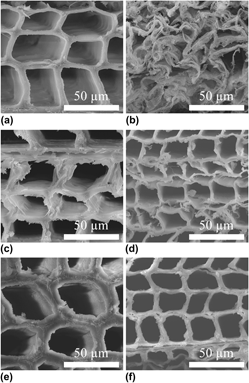Crossref Citations
This article has been cited by the following publications. This list is generated based on data provided by
Crossref.
Zollfrank, Cordt
Cromme, Peter
Rauch, Marcus
Scheel, Hanne
Kostova, Mariya H.
Gutbrod, Kai
Gruber, Sabine
and
Van Opdenbosch, Daniel
2012.
Biotemplating of inorganic functional materials from polysaccharides.
Bioinspired, Biomimetic and Nanobiomaterials,
Vol. 1,
Issue. 1,
p.
13.
Van Opdenbosch, Daniel
Thielen, Marc
Seidel, Robin
Fritz-Popovski, Gerhard
Fey, Tobias
Paris, Oskar
Speck, Thomas
and
Zollfrank, Cordt
2012.
The pomelo peel and derived nanoscale-precision gradient silica foams.
Bioinspired, Biomimetic and Nanobiomaterials,
Vol. 1,
Issue. 2,
p.
117.
Studart, André R.
2012.
Towards High‐Performance Bioinspired Composites.
Advanced Materials,
Vol. 24,
Issue. 37,
p.
5024.
Fritz-Popovski, Gerhard
2013.
Two-dimensional indirect Fourier transformation for evaluation of small-angle scattering data of oriented samples.
Journal of Applied Crystallography,
Vol. 46,
Issue. 5,
p.
1447.
Van Opdenbosch, Daniel
Dörrstein, Jörg
Klaithong, Somruedee
Kornprobst, Tobias
Plank, Johann
Hietala, Sami
and
Zollfrank, Cordt
2013.
Chemistry and water-repelling properties of phenyl-incorporating wood composites.
hfsg,
Vol. 67,
Issue. 8,
p.
931.
Paris, Oskar
Fritz‐Popovski, Gerhard
Van Opdenbosch, Daniel
and
Zollfrank, Cordt
2013.
Recent Progress in the Replication of Hierarchical Biological Tissues.
Advanced Functional Materials,
Vol. 23,
Issue. 36,
p.
4408.
Niu, Li-na
Jiao, Kai
Ryou, Heonjune
Diogenes, Anibal
Yiu, Cynthia K. Y.
Mazzoni, Annalisa
Chen, Ji-hua
Arola, Dwayne D.
Hargreaves, Kenneth M.
Pashley, David H.
and
Tay, Franklin R.
2013.
Biomimetic Silicification of Demineralized Hierarchical Collagenous Tissues.
Biomacromolecules,
Vol. 14,
Issue. 5,
p.
1661.
Fritz‐Popovski, Gerhard
Van Opdenbosch, Daniel
Zollfrank, Cordt
Aichmayer, Barbara
and
Paris, Oskar
2013.
Development of the Fibrillar and Microfibrillar Structure During Biomimetic Mineralization of Wood.
Advanced Functional Materials,
Vol. 23,
Issue. 10,
p.
1265.
Dietrich, Dagmar
Lampke, Thomas
and
Rößler, Ronny
2013.
A microstructure study on silicified wood from the Permian Petrified Forest of Chemnitz.
Paläontologische Zeitschrift,
Vol. 87,
Issue. 3,
p.
397.
Cabane, Etienne
Keplinger, Tobias
Merk, Vivian
Hass, Philipp
and
Burgert, Ingo
2014.
Renewable and Functional Wood Materials by Grafting Polymerization Within Cell Walls.
ChemSusChem,
Vol. 7,
Issue. 4,
p.
1020.
Fritz-Popovski, Gerhard
Morak, Roland
Schöberl, Thomas
Van Opdenbosch, Daniel
Zollfrank, Cordt
and
Paris, Oskar
2014.
Pore characteristics and mechanical properties of silica templated by wood.
Bioinspired, Biomimetic and Nanobiomaterials,
Vol. 3,
Issue. 3,
p.
160.
Zollfrank, Cordt
Scheibel, Thomas
Seitz, Heike
and
Travitzky, Nahum
2014.
Ullmann's Encyclopedia of Industrial Chemistry.
p.
1.
Daud, Norlinda
and
Shanks, Robert
2014.
Epoxy–silica composites replicating wood cell structure.
Composites Part A: Applied Science and Manufacturing,
Vol. 62,
Issue. ,
p.
11.
Townson, Jason L.
Lin, Yu-Shen
Chou, Stanley S.
Awad, Yasmine H.
Coker, Eric N.
Brinker, C. Jeffrey
and
Kaehr, Bryan
2014.
Synthetic fossilization of soft biological tissues and their shape-preserving transformation into silica or electron-conductive replicas.
Nature Communications,
Vol. 5,
Issue. 1,
Van Opdenbosch, Daniel
and
Zollfrank, Cordt
2014.
Cellulose‐Based Biotemplated Silica Structuring.
Advanced Engineering Materials,
Vol. 16,
Issue. 6,
p.
699.
Jancar, Josef
2015.
Multifunctionality of Polymer Composites.
p.
903.
Fritz-Popovski, Gerhard
2015.
Interpretation of two-dimensional real-space functions obtained from small-angle scattering data of oriented microstructures.
Journal of Applied Crystallography,
Vol. 48,
Issue. 1,
p.
44.
Boury, B.
and
Plumejeau, S.
2015.
Metal oxides and polysaccharides: an efficient hybrid association for materials chemistry.
Green Chemistry,
Vol. 17,
Issue. 1,
p.
72.
Zhu, Gang-Tian
Chen, Xi
He, Xiao-Mei
Zhang, Zheng
Li, Xiao-Shui
Yuan, Bi-Feng
and
Feng, Yu-Qi
2015.
Bioinspired preparation of monolithic ordered mesoporous silica for enrichment of endogenous peptides.
RSC Advances,
Vol. 5,
Issue. 92,
p.
75341.
Burgert, I.
Cabane, E.
Zollfrank, C.
and
Berglund, L.
2015.
Bio-inspired functional wood-based materials – hybrids and replicates.
International Materials Reviews,
Vol. 60,
Issue. 8,
p.
431.





